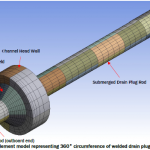
Our Services Fatigue
Fatigue is a damage mechanism which often leads to fracture of components in service where they are subject to cyclic loading. Fatigue cracks are initiated from points of high stress concentration on the surface of components.
Cyclic loading causes the cracks to propagate through the remaining cross section until it reaches a critical size when fast-fracture results in failure. Fatigue failures often occur under cyclic loading below the elastic limit of the material. Unlike static loads, where the absolute value of stress is considered, the stress range between plant states is considered in fatigue assessments.
The stress ranges under cyclic loading can be obtained using the analytical or numerical analysis methods described here. The acceptance criteria for fatigue assessments is by means of fatigue endurance data specific to the material under consideration.
The data is often supplied in the form as stress vs cycles to failure curve, commonly referred to as “S-N curve”. These are obtained from cyclic tests performed on laboratory specimens. The calculated stress range value can be read from the S-N curve to obtain the number of cycles to failure or vice-versa.










